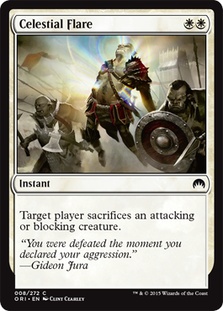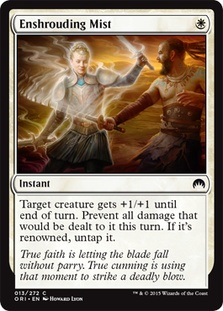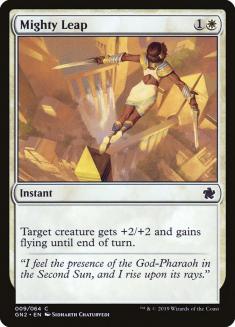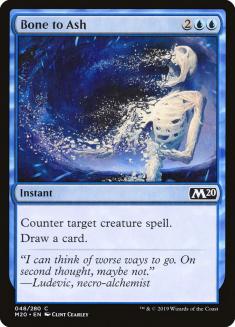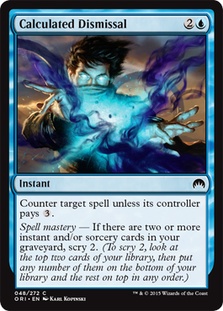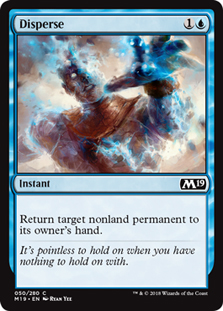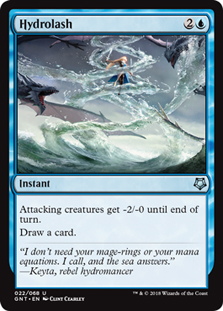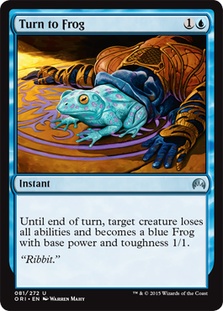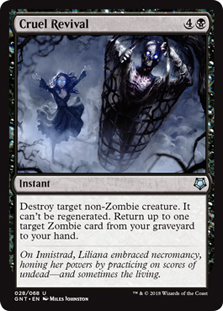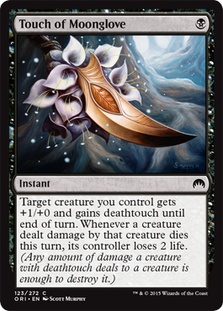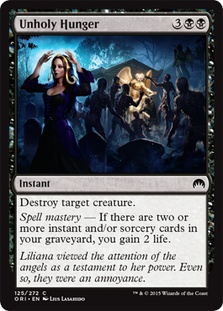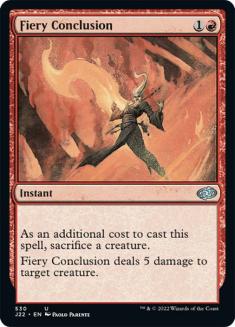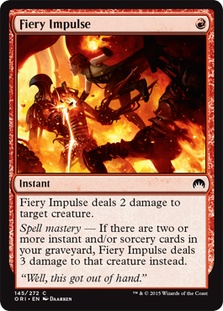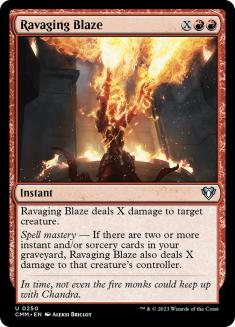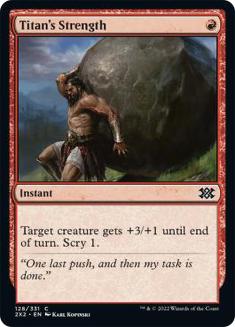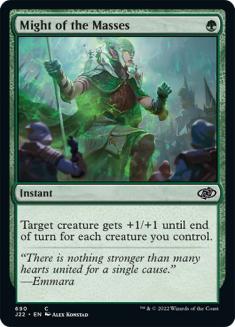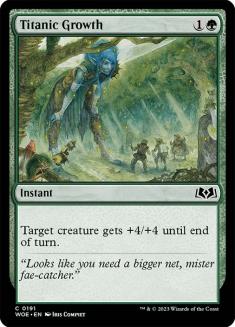The full card list for Magic Origins is out and everybody is talking about the new set. I spoke a little bit in my article two weeks ago about the cards that I thought would be good in the new Standard environment, so this week I want to spend time talking about one my favorite tournaments: prereleases! If you’ve never been to a prerelease before, I highly recommend the experience as they are generally the most fun tournaments of the year. I’m used to playing in a very competitive setting, so being able to spend a weekend just playing for fun and to learn is something that I greatly appreciate. This is an attitude that is shared by almost everyone that goes to these events, so you’re likely to be playing amongst good company. Prereleases also tend to bring players out of retirement, so to speak, as they get excited for the new set and get the itch to play again.
If you are going to your local prerelease this weekend, I have a few tips that I think will improve your experience. I think that these tips are useful for anyone, not just beginners. Even experienced players make mistakes, especially when all of the cards are new.
Tip #1: Read Your Cards
This may sound like very basic advice, but you’d be surprised how often you can make a mistake because you misunderstood exactly how a card works. It’s especially important to read and even re-read your cards at the prerelease since you’re unfamiliar with almost all of the cards at this particular event. This is true for your opponents’ cards as well, since it’s very easy to accidentally misinterpret a card your opponent plays during a game.
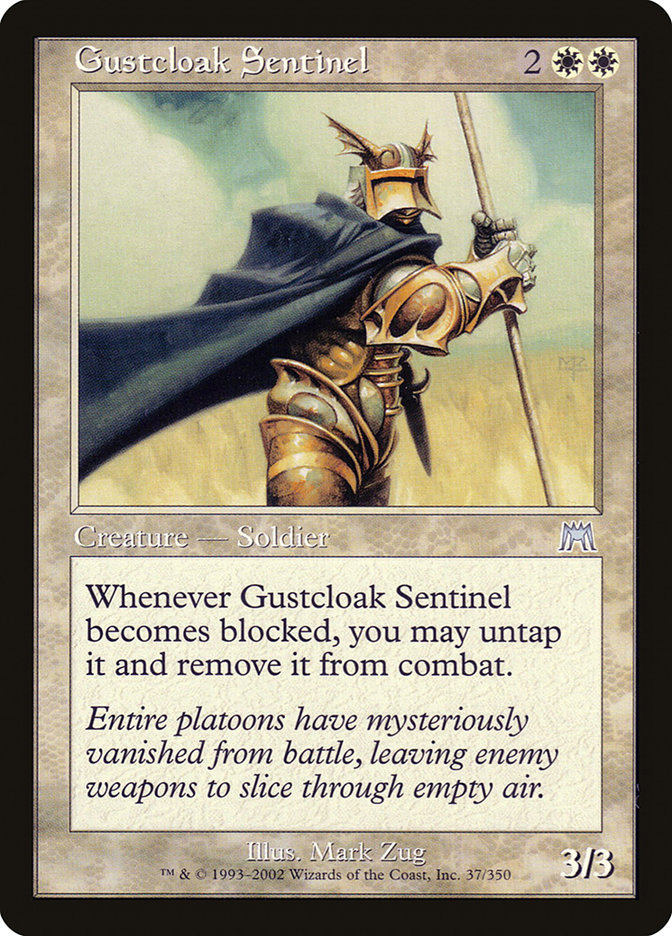 A great example of this was when I was practicing Onslaught Limited against national treasure Patrick Sullivan. I had a copy of Gustcloak Sentinel on the battlefield and in the picture the card has a soaring cape, so I thought it had flying. I announced an attack for three in the air, and Patrick took it. I attacked the next turn and Patrick took it again, despite having creatures that could block. The third time I attacked Patrick picked up the card and said “Wow this card is absurd” and conceded the game. It was only after the match that we both realized that the card didn’t actually have flying.
A great example of this was when I was practicing Onslaught Limited against national treasure Patrick Sullivan. I had a copy of Gustcloak Sentinel on the battlefield and in the picture the card has a soaring cape, so I thought it had flying. I announced an attack for three in the air, and Patrick took it. I attacked the next turn and Patrick took it again, despite having creatures that could block. The third time I attacked Patrick picked up the card and said “Wow this card is absurd” and conceded the game. It was only after the match that we both realized that the card didn’t actually have flying.
This exact situation type of situation happens a lot, since there are a lot of cards that look like they would have flying based on their art. It’s important to always read the full text of the cards on the battlefield, since there are often small details that you can miss when you just skim them or don’t read them at all. At Grand Prix Las Vegas, a friend of mine accidentally returned an Arcane spell to his hand using a Soulshift trigger. He had played during the original Kamigawa block, so many of the Spirits cards in Modern Masters trigger off both Spirits and Arcane that he had mentally thought that the Soulshift trigger could return Arcane spells as well. Luckily, he didn’t get a game loss for the mistake since he caught it soon after. This story actually brings me to my next tip:
Tip #2: Don’t Hesitate To Call A Judge
This tip doesn’t just apply to the prerelease but to all Magic tournaments. Whenever any problem comes up during a game, you should always call a judge. Even if you think that you understand how something works, it never hurts to call a judge. In the last situation at Grand Prix Las Vegas, my friend’s opponent commented on how good Soulshift was with Death Denied (the card he illegally returned with Soulshift) and my friend realized that it wasn’t a legal target. The Death Denied was returned to my friends hand during his opponents combat, and he had cast the spell at end of turn. During the resolution of the spell he re-read the rules text on Soulshift and realized that he had made an illegal play and immediately called a judge on himself. He ended up getting a Warning, but because he had realized his own mistake, and corrected it with the judging staff quickly enough, he was able to avoid any further penalties.
If you accidentally make an illegal play, or you realize that your opponent made an illegal play, you should always call a judge immediately. Judges are there to help you and often any amount of time spent on rulings will be given back to matches as additional time. At the prerelease, the Rules Enforcement Level, or REL, is very low so you will not be actively punished if you accidentally make a mistake. Other events such as Grand Prix have higher RELs, so in those events, the penalties for infractions will be more severe.
Tip #3: Feel Free To Change Your Deck
The prerelease is one of the only events where you are able to change your deck in between rounds. Years ago, if you wanted to make changes to your deck after deckbuilding, you would only be able to through sideboarding before games two and three of your future rounds. In recent years, the DCI changed it so that you could rebuild your deck between rounds at the prerelease and other non-competitive events. This is a great opportunity that you can only take advantage of at events like this, so I recommend that you consider it this weekend.
When I attend the prerelease, I often swap decks with my friends to see if we would play anything different in each other’s sealed pools. A lot of the time, your friends will see something that you didn’t see when you were sitting down for the deckbuilding portion. If you have experienced friends, I would definitely listen to what they have to say about cards or colors that you may have overlooked in your pool. Also remember that while this practice is allowed at the prerelease, you cannot do this at any other competitive event and you will get penalized if you do, so make sure you always check with a judge first.
Tip #4: Understand What Tricks You’ll See
Understanding what cards are in a format is very important when playing games of Limited. In particular, it’s important to understand what instants you may play against over the course of the tournament. This type of information is very important since it will help you figure out how to proceed based on what colors your opponent is playing. Knowing which cards your opponent could potentially have greatly increases your chances of finding the best possible play. I think that these are the most common tricks you are likely to play against:
White:
Blue:
Black:
Red:
Green:
It’s interesting that each color actually has a few playable instants and that green actually has the least number of combat tricks that most people would want to play in their maindeck. Might of the Masses is the type of card that you’re going to have to consider when making blocks against a green deck since it can come out of nowhere to change combat or even quickly kill you. Board states in Sealed often bog down while both players play more creatures and Might of the Masses has to potential to turn one unblocked creature into a lethal attack on the right board. While it is important to know about these cards, don’t feel obligated to play around all of these all the time. Sometimes it actually makes sense to play into your opponent to see what they have, especially in game one. In games two and three, you are able to make way more informed decisions after you’ve seen much more of their deck.
Tip #5: Understand The (In-Game) Value Of Your Cards
When I say the value, I don’t mean the financial value but rather their importance and utility in your Limited games. The most important cards in a given sealed pool are usually the bombs, the creatures with evasion and the removal spells. If your pool only has a few removal spells, you have to be more careful and not waste them too early in the game. This idea usually manifests itself in a situation where your opponent has an early creature that is attacking you for damage and you have to choose between using one of your only removal spells on it or taking a few points of damage until you can drop your own creature to block. If your sealed deck is light on removal, it is often correct to use your life total as a resource so that you can save your precious answers for your opponent’s better creatures. On the other side of the coin, it is often correct not to play your bombs as soon as possible, since your opponents will be able to quickly answer them using their own removal spells.
In a lot of situations, it actually makes sense to play your other threats first in order to force your opponents to unknowingly waste their removal. Overall you should look carefully at the final build of your sealed deck, and think about how valuable specific cards are in game. One basic rule that you can follow is the rule of “don’t eat all you candy at once.” Ever since I was a kid I really loved candy, in particular Sour Patch Kids, Swedish Fish, and Gummy Bears. I wanted the candy and I wanted it immediately. As I grew older, I learned to realize that candy is something that is nice to have, but too much of it and too much of it all at once is not good.
Now let’s relate this to Magic. If you have one creature and four removal spells in your hand, it is normally better to not trade off your creature and instead clear a path for it. On the other end of the spectrum if you have lots of creatures and only one removal spell, focus on trading off creatures. Each game is different and this is not always the best way to go about things, but it’s definitely something to consider and think about. Understanding the value of a card is just as important as understanding the role of the card. Whether it is a creature, land, or spell, the value and role shifts depending on your hand, board state, and life total. Understanding this and considering all your options before each play is important.
Tip #6: Understand The (Monetary) Value Of Your Cards
The value of cards on the secondary market is often in flux around the prerelease since this is the first time players will actually have access to the physical cards. If you don’t need any of the cards you open, then feel free to trade them to other players for cards you do need. The prices of cards in the new set are often at their highest at the prerelease, so this is likely to be the best time to trade away new cards that you don’t need. At the same time, it’s also a great time to pick up cards that you think are currently undervalued. A recent example is Sphinx’s Revelation, which was underrated at the prerelease but quickly gained in value as the Standard season progressed. Other cards to look out for at the prerelease are Eternal staples and foils. These cards are often undervalued out of the gate and then gain value later on once they see play. If you’re interested in the financial side of Magic Origins, then I would recommend checking out Ben Bleiweiss series on this site. He spends a great amount of time before each set looking at the current and future values of cards. His work is excellent and enjoyable if you pay attention to the monetary aspect of Magic.
Tip #7: Ask Whether Your Deck Wants To Play Or Draw
I hate to have to say this, because I feel many players don’t really consider this enough and it kinds of makes sense why players don’t. When you sit down and roll for choice, almost always you are rolling for who will go first. This is extremely true for Constructed, since I can’t really think of many decks besides Manaless Dredge in Legacy that wants to be on the draw. However, in Limited wanting to be on the draw is much more common. For Magic Origins, there are a handful of cards or deck strategies that might want to put you on the draw. Cards such as Eyeblight Massacre, Fleshbag Marauder, Nightsnare, Reave Soul, Elvish Visionary, Hitchclaw Recluse, or Nivix Barrier are a few example of Sultai-colored cards that may work better on the draw than on the play. Remember: sometimes it’s not what your deck is trying to do but what your opponent is trying to do that should influence your decisions. If they are a five-color green deck, it might be correct to put them on the play in hopes they stumble early since decks like that often want to have access to as many cards as possible in order to find their colors. Putting them on the play sometimes forces them to mulligan or keep a loose hand. Regardless of what you decide on, just take some time to consider both options rather than just snap off the play.
I’m very excited to play in the Magic Origins prerelease this weekend and I hope to see some of you there. As for colors, I think I’m either going to pick black or blue, but I don’t think that it really matters as much as people think it does. The seeded packs for Magic Origins are only seven cards, and may not even fit into your pool anyway. I would recommend picking whichever color you think you will have the most fun playing. If you love playing green, then pick green! If you hate red, then don’t pick it (another shout-out to Patrick Sullivan, thirteen years later and that story still makes me smile)!
The prerelease is a ton of fun and I hope you try playing in one this weekend, especially if you haven’t before. Also, don’t be afraid to sideboard in Dreadwaters because I feel like that can be a sleeper card in this set. If you guys and gals have any sleeper cards for Sealed Deck from Origins, I would love to hear about them!

